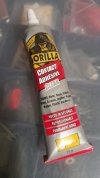JimmyB
Now retired - trains and fishing
As some of you will have seen I am now in the possession on the OcCre San Francisco Streetcar, Having read through the instructions and watched the videos, I would appreciate some advice as there seems to be some contradictions, the instructions inform to use:
Use white glue for wood,
Use fast-acting glue for part difficult to hold in position, and small parts.
Use transparent contact adhesive for window to frames.
However watching the video it would seems that "super glue" is used throughout. my assumptions are
White glue is PVA wood glue,
Fast acting glue is super glue, but there are various types these days which one,
However what is "transparent contact adhesive"
Some pointers would be appreciated, many thanks.
Use white glue for wood,
Use fast-acting glue for part difficult to hold in position, and small parts.
Use transparent contact adhesive for window to frames.
However watching the video it would seems that "super glue" is used throughout. my assumptions are
White glue is PVA wood glue,
Fast acting glue is super glue, but there are various types these days which one,
However what is "transparent contact adhesive"
Some pointers would be appreciated, many thanks.



